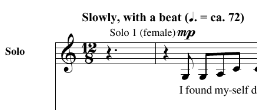While dancers definitely don’t need to be able to read music, it is helpful to be able to dig up sheet music for a song and understand the meter and tempo markings. This can act as a sanity check against what you hear, tap out in a tempo counter, or find by just stepping out the dance.
The catch is that the simple idea that 3/4 meter is a waltz and 4/4 is everything else only gets you so far. What is 12/8 or 2/2? Can you even dance to music that is marked in those ways and others? How to Read Music in 30 Days describes simple and compound meters and tempo markings in enough detail to get your head wrapped around these markings and translate them back to something meaningful to a dancer.
Last year, I wrote a blog post about how musicians and dancers might think of tempo differently. In that case, it was a simple matter of the written music and the musician thinking about the pulse or underlying beat as being twice the tempo as the dancer does.
In the case that prompted this post, I was asked about “Like I’m Gonna Lose You,” by Meghan Trainor featuring John Legend which is marked as 12/8 with a dotted quarter note = 72 beats per minute.

This could be translated to a 3/4 meter at 72 measures per minute or 216 beats per minute. That would be a very fast Viennese Waltz, which is what 6 people have voted for. Alternatively, one could translate this to 4/4 time 72 beats per minute or 18 measures per minute, which would make a good Slow Dance, Blues Dance, or a very slow West Coast Swing, all of which have votes. See the book for how to do these translations; it’s explained better there than I can manage.
Since I can only have one tempo listed per song, I’m a little stuck on being able to get the “dancer’s tempo” correct for songs that can be danced to different interpretations of the beat. I’m starting to think about reworking music4dance so we can override the tempo on a per-dance style basis. That’s a pretty significant lift for a small number of songs. But this keeps coming up, so let me know what you think. If I get enough people asking for this, I’ll figure out how to make it work.
This is a topic that I’ve touched on quite a bit, so here are some other posts and resources that might be of interest:
- If you are still in the stage of learning to dance, rather than digging deep into different types of meters, I’d recommend reading Hear the Beat, Feel the Music which I blogged about here.
- Another fun post about how dancers think about music is Do Dancers think in Eights?
- What is a Fake Waltz? covers some of how I’ve thought about cataloging dances by rhythm.
- I used the Tempo Counter and Dance Tempo tools on the site to check the tempo of the song and look up the tempos of dances.
As always, I’m very interested in your feedback, so please share any thoughts and ideas about this post or the site by commenting below or using other feedback mechanisms listed here. In addition, if you enjoy the site or the blog (or both), please consider contributing in whatever way that makes sense for you.
How to Read Music in 30 Days: Paperback
How to Read Music in 30 Days: Hardcover
How to Read Music in 30 Days: Spiral Bound
Note: If you found this book through this blog, please be kind and click on one of the links above to purchase it. This helps support the blog. If you’re feeling especially generous (or just like the blog a lot), clicking on the Amazon links in the blog or on the music4dance site and then doing your regular, unrelated shopping, which also helps support the site as a very small fraction of those proceeds will be directed to musci4dance.





